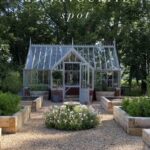If you’re a gardening enthusiast looking to maximize your space and extend your growing season, a backyard greenhouse may be just the solution you’re looking for. Greenhouses are a great way to create a controlled environment for your plants to thrive in, allowing you to grow a wider variety of fruits, vegetables, flowers, and herbs all year round. However, when it comes to designing a functional backyard greenhouse, it’s important to carefully consider the layout and organization of the space to ensure optimal efficiency and productivity.
One of the first things to consider when designing a backyard greenhouse is the size and shape of the structure. While larger greenhouses offer more growing space, they also require more maintenance and energy to heat and cool. Smaller greenhouses, on the other hand, are easier to maintain but may limit the types and quantities of plants you can grow. The key is to strike a balance between your available space, budget, and gardening needs.
In terms of layout, it’s important to plan for efficient use of space in your greenhouse. Start by organizing your plants based on their specific needs, such as light, temperature, and humidity requirements. Consider using shelving, hanging baskets, or trellises to optimize vertical space and make the most of limited floor space. You can also implement a zone system to separate plants that need different levels of care or conditions.
Another important aspect of maximizing space in a backyard greenhouse is proper ventilation and heating. Ensure that your greenhouse is well-ventilated to prevent overheating and humidity buildup, which can lead to mold and disease. In colder months, consider using a space heater or heating mats to maintain an optimal temperature for your plants. It’s also a good idea to install a thermostat and automatic vents or fans to regulate the temperature inside the greenhouse.
When it comes to watering, fertilizing, and pest control, it’s important to stay organized and efficient to keep your plants healthy and thriving. Consider installing a drip irrigation system or self-watering containers to ensure that your plants are getting the right amount of water without wasting it. Use organic fertilizers and pest control methods to keep your greenhouse free of harmful chemicals and toxins.
Overall, designing a functional backyard greenhouse is all about maximizing space and efficiency to create an optimal growing environment for your plants. By carefully planning the layout, ventilation, heating, and watering systems, you can create a space that not only looks beautiful but also produces healthy, bountiful crops year-round. So roll up your sleeves, grab your gardening tools, and get ready to transform your backyard into a lush oasis with a well-designed greenhouse.




















